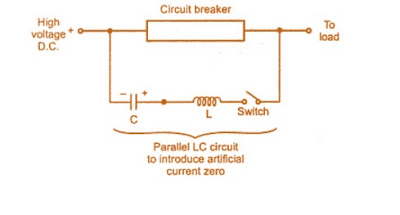In AC circuit breakers/ arc extinction is achieved at the natural current zero of the AC waveform used. But in DC circuit breakers / natural zero of voltage and current is not available as both are continuously available. Thus for extinction of an arc, artificial current zero is required to be introduced. Such an artificial current zero is possible by connecting LC circuit in parallel with the circuit breaker. The LC circuit is responsible to produce oscillatory arc currents having many artificial current zeros. At one of the artificial current zero arc gets extinguished.
The HVDC circuit breaker is nothing but a Vacuum Circuit Breaker. The LC circuit along with a switch is connected in parallel with this circuit breaker.
The capacitor C used is pre-charged capacitor with the polarities as shown in the Figure.
When the circuit breaker starts opening, the switch in the LC circuit gets closed. Due to the charged capacitor, the discharging current starts flowing in opposite direction to that of load current carried by the circuit breaker. Due to this, arcing current starts oscillating producing many natural zeros. Thus artificial commutation results and arc extinction is achieved.
The large Transient Recovery Voltage is the main constraint in HVDC Circuit Breaker and Circuit Breaker must able to withstand it. For successful operation of such a Circuit Breaker, the switch in LC circuit must be a high speed switch with a very fast response. Such systems are complex and very costly as they require costly protection and control system.

